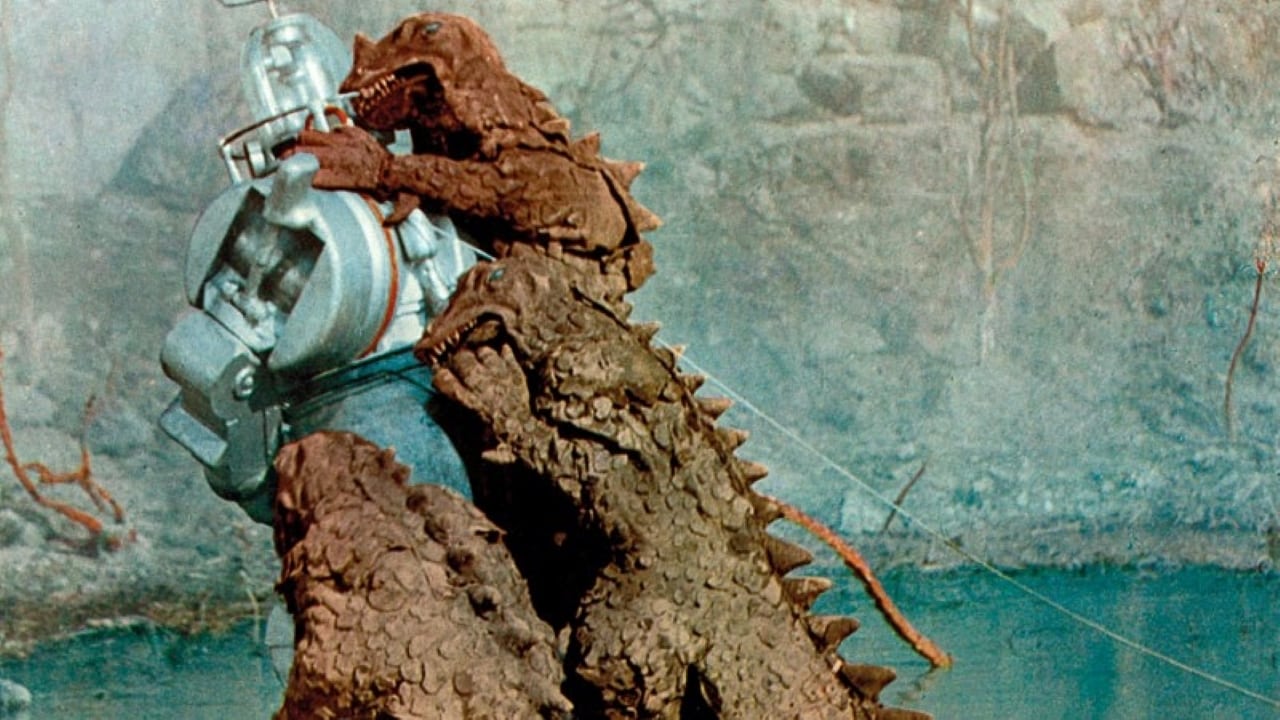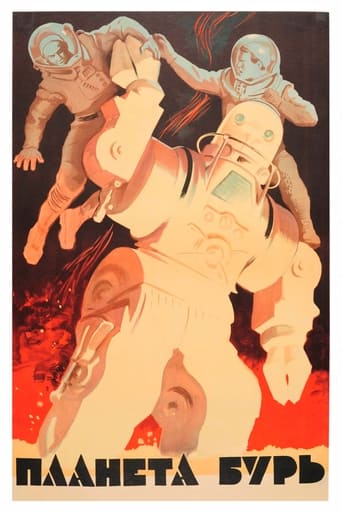Limerculer
A waste of 90 minutes of my life
filippaberry84
I think this is a new genre that they're all sort of working their way through it and haven't got all the kinks worked out yet but it's a genre that works for me.
Sienna-Rose Mclaughlin
The movie really just wants to entertain people.
Skyler
Great movie. Not sure what people expected but I found it highly entertaining.
dromasca
My movie memory has the strange habit of sticking often to the movies seen many years ago the place and circumstances in which I saw the movie. I was about ten years old when I first saw the 'Storms Planet'. The year was about 1963, in my native Romania. The recent re-viewing of the Soviet film that was originally called 'Planet Bur' has also brought me a journey in time by watching this film about a space trip. It may have been one of the first science fiction films I've ever seen, if not the first, from a long series that continues until today, because the passion for the genre born in those years has not diminished, but on the contrary . It was probably also one of the first Soviet films that I saw, a singular and quite special film even in the scene of the Soviet cinema of those years.In fact, there was a race in parallel to the space exploration race between the two great superpowers - the Soviet Union and the United States - representing the two political systems that were involved in the Cold War complex system of relations that included armed diplomacy and a balance of nuclear terror. Cinematography as a popular art form with the largest distribution among the general public tried to mirror this competition.As far as we know, 'The Storm Planet' was the only film of fiction directed by Klushantsev. The scientific orientation of the team he worked with is evident in the attention paid to the scientific elements in relation to the lean and conventional structure of intrigue and narrative. If the image of spacecraft does not impress us compared to the effects created on the computer we are used to today, the scenes of imponderability or the naturalistic description of the contact between people and the monsters that inhabit the planet are executed with precision. Even in the perspective of today, after hundreds of science fiction films watched in half a century, some scenes remain for me expressive. Others are less successful, for example, the dinosaur silhouettes with which Klushantsev and his colleagues have populated the planet seem to be taken from the illustrations in a school manual. The intrigue itself does not offer too much reason to comment, it's as complex as an episode of the 'Star Trek' television series that would appear a few years later. Cosmonauts are surprisingly independent, and after one of the three spaceships of the mission is destroyed by a meteorite they decide on their own, with Soviet abnegation, to continue the mission. The two exploring teams are lost momentarily and will look for each other to face the dangers. The only woman in the crew will also have to make a crucial life and death decision. Heroism and devotion to space.Surprising (in good) is the rather small amount of propaganda in a movie that was also intended to respond to similar American films. In a single moment of the film,we are served with a thank-you speech for the Soviet peoples' support. There is also a non-Soviet character, researcher Kern, who has a little of the 'capitalist' ideas but is still a positive character. We are told that he is funded by an independent group of researchers. The concept of an international mission was not born yet, but we are on the right track. The Americans would reciprocate with the presence of Commander Chekhov on the command deck of the first Star Trek mission. Kern is also the manipulator of the John robot, which is pretty well done as a cinematic vision, and one of the first robots in the history of the film capable not only of intelligence and a spirit of sacrifice but also of a sense of humor. The film is less good in what concerns the costumes worn during the orbital voyage, the style of the elegant space uniforms has not yet come.The film's scientific aspects also include some weaknesses. The choice of the planet Venus as a target of exploration reflects the state of scientific knowledge existing in the early 60's. The atmospheric conditions on Venus (as well as Mars otherwise) were little known and both the Soviets and the Americans sent automatic probes to both planets. Subsequent data (largely provided by the Soviet probes) would show that the atmosphere of Venus is composed of poisonous gases, temperatures and atmospheric pressure are extremely high, and life as imagined in the film is virtually impossible. In one field, the authors stumbled precisely - the storms. Otherwise, the opening of the space helmet on the surface of the planet as it happens in one of the scenes would immediately kill the astronauts. Overall it's a piece of nostalgia worth viewing or re-viewing.
tedg
I'm of the opinion that film is powerful, powerful enough that large segments of our imagination is guided by cinematic relationships. That even the nature of reasoning is affected, even as deeply as how we reinvent practical logic. There are lots of examples to show and arguments to be made -- they are in a collection I am incubating.Science fiction is a special case, at once more obvious. Not all as subtle as what I study. But surely it had as profound an effect on daily lives.To understand this film, you need to know some history. Alas, many readers will not appreciate the cold war that was the overriding impetus for the two largest political entities from the 50s through the 80s.Some dates for you. In 56, the US saw "Forbidden Planet," with a superintelligent robot, space travel and mind augmentation. It was based on Shakespeare's most interesting play and is still among the best scifi films.In 57, Russia launched a satellite and declared that they "owned" space (and would put nuclear bombs over the US ready to "drop"). Also, that soon, they would have men in space.In 58 one of the most successful Russian filmmakers (Klushantsev) made a film about "cosmonauts" and space travel that was enormously successful with the Russian public (and their captive peoples). That film was the beginning of a deeper than usual partnership between Klushantsev and the propaganda arm of the Kremlin.In 1960, an unknown in East Germany made a film (Road to the Stars) about cosmonauts on Venus. It was a runaway hit. In the following year, Kennedy made his famous pledge to put an American on the moon by the end of the decade.The Soviet moon program had some catastrophic disasters, in large part resulting from lies told to the old Stalin regime by Soviet scientists working on ballistic missiles supposedly (but not really) capable of destroying the US. Khrushchev had these scientists destroyed or imprisoned. That meant no moon program.But the people already were convinced that Venus was the prize, so the space propagandists seized on this and retooled their manned program as a race to Venus, forget the moon. As a consequence, Klushantsev was given a (for the times and conditions) vast budget and told to make a film of the heroic Soviet nation exploring Venus. This he did in the film you'll see here if you can find it.Our intrepid crew is asked to make the Soviet people proud, a promise they come back to a few times. There's a robot, clearly stolen from "Forbidden Planet."The thing revolves around there being life on Venus. Just as they take off, they find proof that the life consisted of humans. Afterthey leave, we see a beautiful woman appear. Then, as the spacecraft flies home, we have a few minutes of a Soviet heroes song in that militant, deliberately fake spontaneous joyous tone of the times.The effects developed by this team would be used in strange circumstances for the next 8 years. This crew filmed fake footage of real spaceflights. The Kremlin was never so bold as to fake a success when everyone knew the missions ended in fiery death. But they did decorate their successes with these true-fake movies. The most famous was the 65 spacewalk of Leonov, wonderfully believable until you wonder who is holding the camera. Oddly, the propagandists assumed that the camera eye was such a magical omnipresence that no one would ask.Anyway, this film was somehow procured by the infamous Roger Corman. He shortened it and dubbed in English. He substituted the blank female (who says in an orbital craft) with an even more blank female. One wonders why; Faith Domergue had been hot 15 years earlier but here is wallpaper. And he adds an earthside leader who radios a few times, played by the already embarrassing Basil Rathbone. Something interesting could be said about his Sherlock Holmes here.Kubrick's 1968 2001, used many conventions from this shop, even when they went against the science of the thing. And ever since, on through "Star Wars," we have that single vision of what space SHOULD look like.Ted's Evaluation -- 2 of 3: Has some interesting elements.
wdbasinger
If one wants to learn some Russian (which I would like to do if I could find the time), then this film would give some insights.I bought the version from Sinister Cinema which seems to be missing the first half and so it starts with the cosmonauts discussing a tragic collision in space as they prepare to embark on a trip to Venus. It is in Russian with English subtitles and the special effects and the background music are both awesome. The story is pretty straight forward about a Russian expedition to the planet Venus, their encounter with dinosaurs and other strange life forms, philosophical discussions about the role of man in space, speculation about extraterrestrial intelligent life, and an ironic ending in which intelligent humanoid life is shown to exist on Venus, yet there is no contact between them and earth-born humans. Perhaps the writers intended a sequel.Just like a lot of the German films from the 1930s, there is very little or no ideological propaganda, even though there is one reference to the Communist Party, Government, and the Soviet Union (thankfully a thing of the past). But aside from that single sentence, there is no reference to anything political. The story centers around a group of cosmonauts that represent not just Russia, but all of humanity as a whole as the crew embarks on an exploratory mission of the planet Venus. Recommended highly.Dan Basinger
Nitrate-4
This is really an excellent film. Concerning a landing on Venus by cosmonauts( 6 men, 1 woman and a robot) and their many experiences trying to rescue stranded crew members, the film is well-written with outstanding sets depicting the Veneusian landscape. Unlike in much American Sci-Fi of the period, there are no evil aliens trying to take out our heroes, The only inhabitants they meet are carniverous plants, a peredactyl, and lizard-men( in one of the few poorly done scenes) This is is an excellent film and should be viewed by all Sci-Fi fans.

